16th Lancers
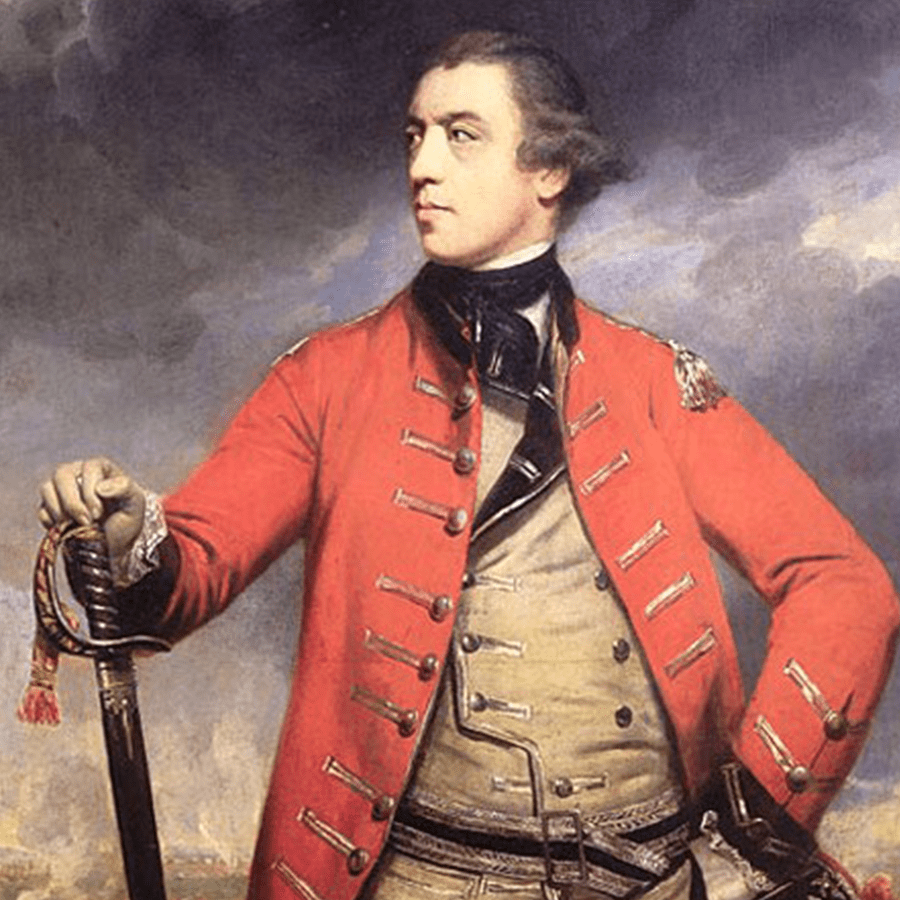
Raising of the Regiment 1759
The 16th was first raised in 1759 and was amalgamated with the 5th in 1922 to form the 16th/5th Lancers. It is most famous for riding in the Charge at Aliwal in 1846.
In 1759 it was decided to follow the example of continental armies and form regiments of light cavalry as it was thought that this cheaper form of cavalry would be better suited to conduct vedette, reconnaissance, scouting and flank guard duties. Thus on the 4th of August 1759 Colonel Burgoyne was appointed commanding officer of the 16th Light Dragoons, a regiment to be raised in Northampton. He wrote his own recruiting poster, ending: “You will be mounted on the finest horses … Your society will be courted; You are admired by the Fair … Young men out of employment or uncomfortable … nick in instantly and enlist.”
The Regiment’s first foreign deployment came in 1762 when they were embarked for Portugal with whom Britain was allied against the French and Spanish. The Regiment fought their first action at Valencia de Alcantara in Spain. Here Burgoyne commanded the Regiment and a mixed brigade of British and Portuguese infantry. In this action the allied troops surprised and defeated a numerically superior force capturing the commanding Spanish general, and destroying the Regiment of Seville. On their return to England the new Regiment found that they had gained a considerable reputation for their exploits. As a result in 1766 the Regiment was for the first time designated as a Royal Regiment being styled 16th The Queen’s Light Dragoons; adopting Queen Charlotte’s cipher, which to this day is a constituent part of The Queen’s Royal Lancers ‘Queen’s Badge’.
The American War of Independence 1775-1783
In 1763 the Government decided to introduce a Stamp Tax in the North American colonies in order to reduce the cost of garrisoning the colony. This extra tax burden however had an adverse effect; it was the catalyst, which resulted in the colonists revolting against British rule in 1775. The 16th Light Dragoons were one of the regiments sent to reinforce the American Garrison. The voyage to America took the Regiment three months in which both soldiers and their mounts lived in foetid conditions, landing in Halifax, Nova Scotia in October 1776.
Notwithstanding the terrible conditions suffered during the voyage the Regiment was in action within a week of disembarkation, at the Battle of White Plains. The majority of the campaign was spent in pursuit of an elusive enemy. George Washington was well aware that his militia army was not a match for a regular army, he therefore fought a ‘guerrilla style’ war. As a result of American tactics the cavalry were mainly employed in routine patrolling and garrison duties. The 16th returned to England in 1779 prior to the conclusion of the American War of Independence in 1783.
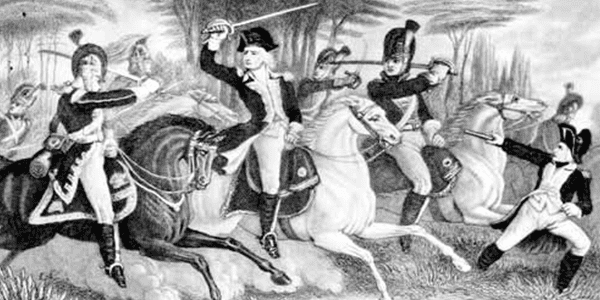
War Against France: Origins 1793
While the American Revolution caused surprise and indignation it was the French Revolution which sent shock waves throughout Europe. It was inconceivable to the monarchies of Europe that one of their number should fall to a revolutionary republican organisation. Thus the European powers were determined to crush revolutionary France, giving rise to a dispute between Britain and France which was to last 22 years. It was to this end that the 16th Light Dragoons were dispatched to Ostend in the spring of 1793 to join the Austrian army. Initially the campaign met with great success with the Regiment gaining the Battle Honours of Beaumont and Willems, where it successfully carried off an entire battery of guns. The campaign however then faltered against the power of the mass mobilised French citizen’s army; as a result the British were forced to withdraw from mainland Europe in February 1796.
The Peninsula Campaign 1809
The French continued to grow in strength on mainland Europe and in 1804 Napoleon Bonaparte declared himself Emperor and the French Empire was born. During his rampage through Europe Napoleon installed puppet dictators in the countries he conquered; he even installed his brother as King of Spain. Britain, in an attempt to stem the growth of Napoleon’s power, once again ventured into Europe as allies of the Portuguese. The campaign in Spain began badly with the retreat to Corunna. As a result, Sir Arthur Wellesley, later the Duke of Wellington, was appointed to command the Army. The 16th Light Dragoons joined Wellington’s Army in April 1809. The Peninsular War was to keep the Regiment from Britain for the next five years, gaining Battle Honours at Talavera in 1809, Fuentes d’Onor in early May 1811, Salamanca in July 1812, and Vittoria in 1813. The 16th also fought in the Pyrenees and ended the war fighting in the battle of Nive. During the campaign in Portugal and Spain, the Regiment fought seven pitched battles with the loss of 309 soldiers and 1416 mounts.
Original Redcoat
Among the many artefacts you can see in the museum is an original ‘redcoat’ as worn by the 16th during the American Revolutionary War.
Crimped Pennons
The Pennons (lance flags) were furled when in action. After the charge at Aliwal the 16th Lancers found these were encrusted with blood and, when unfurled, appeared crimped. It became a regimental tradition that lance pennons are crimped.
Scarlet Lancers
In 1846 when Lancer regiments adopted blue tunics, Queen Victoria allowed the 16th to retain scarlet and the regiment became known as ‘The Scarlet Lancers’.
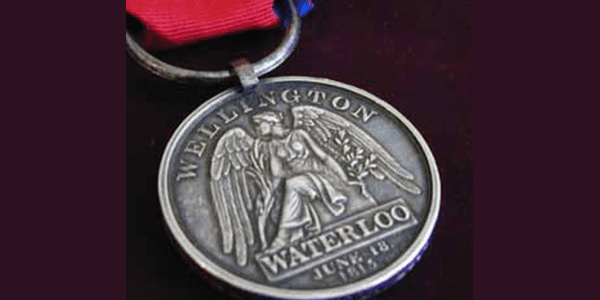
Waterloo 1815
Napoleon’s army pursued Wellington to Waterloo with the armies drawing up into battle lines on the morning of the 18th of June, on what was to be the final and decisive battle of the Napoleonic Wars. The 16th were heavily engaged throughout the day, initially to support the Heavy Brigade under Sir William Ponsonby, which had been ordered to charge retreating French infantry but had pushed the charge too far. As a result, once their horses were blown, they found themselves far from friendly lines and being countered by French lancers as they attempted to rally. It was only the timely intervention of the 16th, which prevented the total destruction of the Heavy Brigade.
With the arrival of the Prussians in the late afternoon Napoleon realised that now outnumbered and out gunned his chances of victory were becoming slim. In a final attempt to break the British he launched his elite Imperial Guard at the British line. The accurate and rapid musketry of the First Guards and 52nd Light Infantry ensured the defeat of the Imperial Guard and the collapse of the French army. It was at this stage that Wellington ordered the general advance and the light cavalry were released to harass the defeated French army. “No one was ever in such a fight before. I think Bonaparte is ruined. We charged four times. I am not touched, my mare is wounded but not badly.” (Cornet Beckwith, 16th Light Dragoons)
Home Service 1816-1822
The 16th Light Dragoons were returned to England in December 1815 and in February 1816 embarked for Ireland and re-designated as lancers. In 1821 they moved to Sheffield; whilst serving there the Regiment came into direct conflict with the Monarch King George IV. Since adopting the title of a ‘Queen’s Regiment’ the 16th Lancers had always been fiercely loyal to the King’s consort. George IV had a particularly bad relationship with his consort, Queen Caroline. The dispute came to a head at the King’s coronation, as the King did not wish his consort to accompany him. The 16th regularly and publicly toasted the Queen to demonstrate their loyalty to her. It was said that when the King heard this he was furious and had the Regiment posted to India in June 1822, where they remained for twenty-four years.
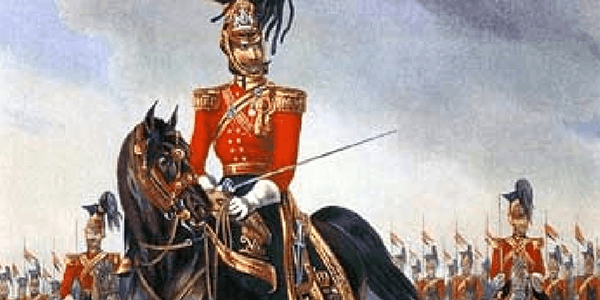
India and Afghanistan 1825-1840
The first active service the 16th Lancers saw in India was in 1825; the Rajah of Bhurtpore had come into conflict with the East India Company and it was decided that an expedition, including the 16th, would be sent to capture the fortress city of Bhurtpore. In the early hours of the 10th December, having completed the night march to Bhurtpore, the 16th encountered and charged a body of Jat horsemen outside the Fortress City, killing 50 of the enemy and capturing 100 mounts. This was the first time that the British Army had bloodied their lances in battle. Bhurtpore was eventually stormed and captured on the 18th of January, and the field force disbanded shortly afterwards.
During the1830’s the Governor General of India had real fears that Russia would infiltrate and control Afghanistan. He therefore decided that it was necessary to invade and then govern Afghanistan. To that end the Army of the Indus was formed to conduct the invasion in order to install the ousted ruler Shah Sujah, who was sympathetic to British interests. The invasion was successfully conducted and on the 7th of August 1839 Shah Shuja entered Kabul escorted by a squadron of the 16th. The Regiment were fortunate enough not to be involved in the retreat from Kabul; the Army of the Indus was disbanded in October 1839 and many of the units returned to India – including the 16th Lancers. They arrived back in Meerut on the 18th of February 1840 having marched 2,483 miles in 463 days. The British Government of India in the 1830s found that the invasion of Afghanistan was considerably simpler than holding it. Shah Sujah was not popular with his people and the British contingent was eventually forced to withdraw.
The Punjab 1845
The Regiment was again in action only five years later – this time against the Sikhs of the Punjab. After the death of Maharajah Ranjeet Singh the State of Punjab fell into a state of near anarchy, with the mutinous Sikh army demanding to be led across the river Sutlej to free their co-religionists living under East India Company rule. On the 11th of December 1845 a Sikh army of 30,000 crossed the Sutlej into Company territory. The 16th were ordered to join General Gough’s army after the first two battles of Mudki and Ferozeshah where British casualties had been high. Gough’s army had pushed deep into the Punjab and was awaiting the arrival of its siege artillery. A separate Sikh force now crossed the river further to the east. Gough was concerned that this force might intercept his artillery train, still en route from Delhi; he therefore dispatched Major General Harry Smith to intercept them. After a difficult march Smith met the Sikhs outside the village of Aliwal on 28th January. The 16th were the only British cavalry in his force.
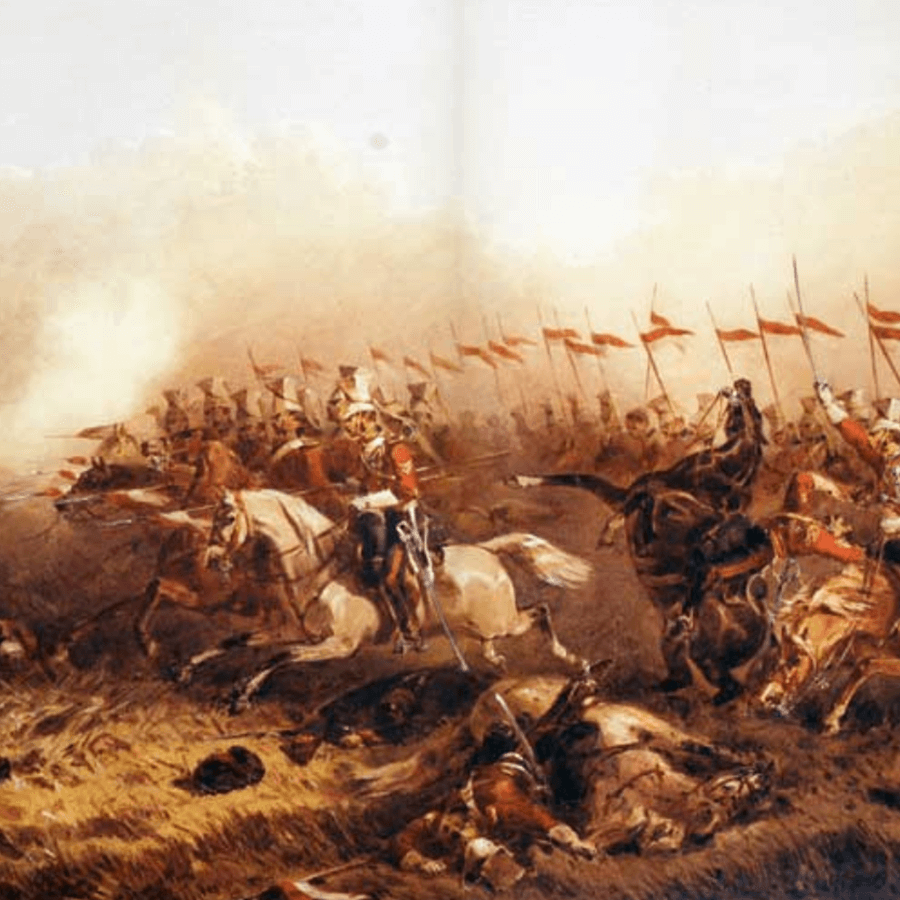
The Charge at Aliwal 1846
The 40,000 Sikh infantry massed against Smith’s 10,000 men at Aliwal covered a frontage of about two miles connecting the villages of Aliwal and Bundri. They were supported by 37 pieces of artillery and flanked by cavalry. In the initial stages of the battle Smith’s forces advanced and took Aliwal. The capture of Aliwal meant the loss of the Sikhs’ best ford across the Sutlej, they therefore had to recapture it and attempted to do so with a body of 1000 cavalry. Smith saw this threat and immediately dispatched a squadron of 16th Lancers and a squadron of the 3rd Bengal Light Cavalry.
The 3rd failed to charge while the squadron of the 16th under Captain Bere did so, and routed 1000 Sikh cavalry (over ten times their number). Aliwal was not lost but the cost to the 16th was the loss of 42 of the 100 who charged. Smith’s main body continued to be harried by the Sikh guns; he therefore ordered the main body of the 16th under their Commanding Officer, Major Rowland Smyth, to take the guns. Smyth led his two squadrons in a headlong charge against the guns that continued to fire until the moment they were overrun. The momentum of the Regiment was so great that they charged past the guns and were faced by the massed squares of the Sikh infantry. Smyth realised that to pull up and retire would enable the Sikh infantry to lay a withering fire in his rear, he therefore spurred his horse, jumping into the centre of the first square and charging on through. Naturally the 16th followed their Commanding Officer and charged head on into the square. “We had to charge a square of infantry – at them we went, the bullets flying round like a hailstorm.” (Sergeant Gould).
A Regimental Tradition
Many were injured including Smyth who received a bayonet wound to his abdomen. However he still managed to reform his Regiment and charge back through the broken Sikh squares. This proved to be the decisive action with the Sikhs breaking contact and attempting to withdraw back across the Sutlej under heavy British artillery fire; they left 3,000 dead and all their guns on the British side of the river.
Of all the Battle Honours gained by the 16th Lancers it was the battle of Aliwal that they chose to commemorate each year. A Regimental tradition deriving from this is that lance pennons were starched and crimped 16 times; this commemorates the fact that after the battle they were so encrusted in blood that they stood upright and stiff. Aliwal continued to be celebrated by the Regiment and The Queen’s Royal Lancers still crimped their lance pennons.

The Scarlet Lancers
By 1840 all Light Dragoon / Lancer Regiments had been instructed by Horse Guards to adopt blue tunics in order to distinguish them from the heavy cavalry. The 16th Lancers had adopted scarlet in 1830 and had become attached to it. As a result the Regiment petitioned The Queen directly that they be allowed to maintain their scarlet. The petition was granted and the 16th became the only light cavalry regiment to wear scarlet. They quickly became known as ‘The Scarlet Lancers’. This tradition remained evident in The Queen’s Royal Lancers with the use of a scarlet backing to the Motto when worn on berets. On their return from India the 16th were garrisoned in Ireland. Having only recently returned home, they did not deploy to the Crimea. The Crimean War was the only major campaign in which the Regiment was not directly involved.
The Boer War 1900-1902
Like most cavalry regiments, the 16th Lancers deployed to the Boer War serving there from 1900 until their eventual return to England in 1904. During the campaign they took part in the Battles of Paardeberg and Diamond Hill, as well as playing a leading role in the Relief of Kimberley. One of the most satisfactory cavalry actions occurred at Klipt Drift on 15th February 1900, when two squadrons of the 16th and one of the 9th Lancers charged to clear the ‘knek’ between two hills, which were occupied by the Boers. The enemy attempted to mount as the Lancers approached, but were swept away and fled in all directions. The Boers left some twenty dead; the Lancers continued their advance for some five miles on towards Kimberley.
By 1909 the 16th had amassed no less than eighteen battle honours, more than any other cavalry regiment in the Army.
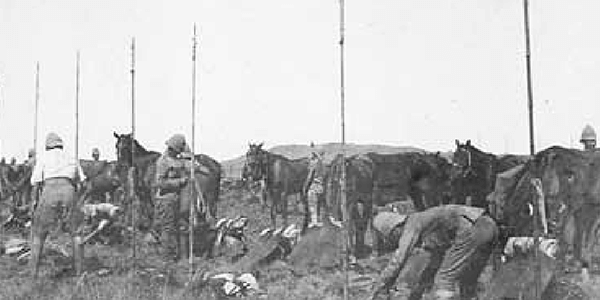
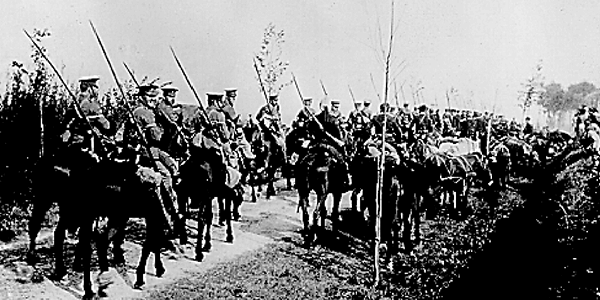
The Great War 1914-1918
During the First World War the Regiment served continuously in France and Flanders in the 3rd Cavalry Brigade with the 5th Lancers. Brigadier (later General) Gough, a 16th Lancer, commanded the Brigade. The First World War did not provide any great scope for cavalry warfare; as a result there were few incidents where the cavalry came into its own. Of particular note was the charge of Lord Strathcona’s Horse at Moreuil Wood on the 30th March 1918. In this action the Strathcon’s counter attack on the advancing Germans, prevented them breaking through the thin British line. It is interesting to note that the 3rd Cavalry Brigade supported the Strathconas and the 16th Lancers played a leading part protecting the Canadian right flank. The 16th were positioned outside the wood and prevented German reinforcements reaching the positions that the Strathconas were trying to clear. Lord Strathcona’s Horse became one of the allied regiments of The Queen’s Royal Lancers.
Also of note during the war was the appointment of Field Marshal Sir William Robertson as Chief of the Imperial General Staff. Robertson had joined the 16th Lancers as a Private and rose through the ranks of the Regiment to be a Troop Sergeant Major. He is the only enlisted soldier ever to have reached the rank of Field Marshal.
With the Armistice in 1918 came a massive reduction of the Army to pre war size and the 16th Lancers found themselves in Syria, an old province of the Ottoman Empire, which now required policing. The Regiment remained there until 1921 when they again embarked for India in preparation for amalgamation with the 5th Lancers, which took place in 1922.
